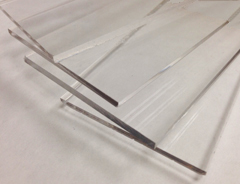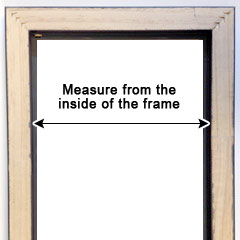| ACRYLIC PLEXIGLASS GLAZING |
 |
|
When most people think of the clear glazing covering the artwork in frames on their walls, they think of good old, traditional glass. But you may be surprised to discover that much of the art you see hanging - especially in galleries and museums - is probably covered by plexiglass or "acrylic" glass, not silicate glass at all.
At KeenARTMedia, we proudly use top quality plexiglass, by a manufacturer who also supplies acrylic for automobiles and airplanes. This article explains what plexiglass is, how it differs from regular glass, and the different styles available.
See our Acrylic Sheets service page to order now.
|
SUMMARY
| WHAT IS PLEXIGLASS? |
PLEXIGLASS VS. GLASS |
GLAZING TYPES |
SIZES |
| A synthetic polymer often used instead of glass. Its chemical name is "methyl methacrylate." |
Plexiglass is lighter than glass, requires less energy to produce, and is generally clearer. |
We offer three types of plexiglass: regular, non-glare, and UV filtering. |
Our plexiglass is available in custom sizes up to 60" x 40", and can be ordered with a frame or alone. |
|
| WHAT IS PLEXIGLASS?
|
 |
|
Plexiglas is a brand name, developed in 1933, for the plastic sheet synthetic polymer "methyl methacrylate." Today, plexiglass has become the common household name (much like kleenex) for this clear, transparent material, which is often used in place of real - silica-based - glass. Other brand names for this so-called acrylic glass are Acrylite and Lucite.
Plexiglass plastic is used as an alternative to polycarbonate, which is much stronger, and contains chemicals that are potentially harmful. Plexiglass is still very strong, however, and in addition to glazing for artwork, is also used for aquariums, viewing ports in submarines, lenses, and some vehicles. Though it is more likely to scratch than other, stronger plastics, plexiglass can be treated to provide high scratch and shatter resistance.
|

Acrylic glass, also called plexiglass
|
| PLEXIGLASS VS. SILICATE GLASS
|
 |
|
Silica-based glass, which is made by melting sand at very high temperatures, is the best known glazing for framed artwork and photographs. Plexiglass sometimes gets a bad name due to the sale of inexpensive picture frames in which a thin, flexible sheet of plastic is used as the glazing.
High quality plexiglass, however, is comparable - and arguably even surpasses - silicate glass in art display.
There are a number of material differences between acrylic and real glass:
- Glass can weigh up to twice as much as acrylic.
This can be dangerous for moving large artwork, especially given the danger if it is dropped. Additionally, larger picture frames can actually bow under the weight of a glass cover. Using acrylic eliminates this risk.
| Plexi Thickness |
Weight |
| Inch |
Millimeter |
Ib |
| 1/16"(.060") |
1.5 |
0.37 / sqft |
| 1/8"(.118") |
3 |
0.70 / sqft |
- Acrylic glass can handle a stronger impact than real glass.
While glass will shatter, acrylic will usually just crack. If it does break, it tends to be into large pieces with blunted edges.
- Acrylic reflects less light than glass, meaning more will go through and illuminate your artwork.
Generally, glass allows in about 80% of light, while acrylic lets in 90-92%, thereby affording a better view of the art.
- Acrylic tends to have a clearer transparency than glass, which can give a green or orange tint to the artwork behind it.
This will give your artwork a color truer to its uncovered appearance, when viewing.
- Acrylic takes less energy than glass to produce and transport.
This makes acrylic an environmentally sound choice. Acrylite, which is used at KeenART Media, is easily recycled and made from up to 75% recycled material.
- Though less breakable, acrylic can be scratched more easily than glass.
Acrylic covers should always be wiped with a soft cloth (not paper_towel). If a damp cloth is required, they must be sprayed with plastic cleaner as opposed to glass cleaner. Unlike glass, however, acrylic is usually sold with a protective paper or plastic cover, so it is perfectly clean when unwrapped, unlike glass which tends to get quite dirty in storage.
|

Plexiglass weighs less than silicate glass
|
| TYPES OF PLEXIGLASS GLAZING
|
 |
|
At KeenART Media, we offer three different types of acrylic glass glazing, all produced by the manufacturer Acrylite. This manufacturer also supplies the acrylic glass used in commercial aircrafts, architecture, and automobiles. Our selection of glazing allows you to select the ideal glazing for your artwork, depending on your needs and personal preferences.
Acrylite acrylic glass is guaranteed defect-free so the art is all you see. All types are 3mm (1/8") thick and come coated in brown paper to protect during shipment.
REGULAR ACRYLIC
The "framing grade" acrylic is perfectly clear, giving a flawless view of your artwork. When placed in the frame, this glazing is indistinguishable from silicate glass, and will keep your art safe and beautifully preserved. It is a great choice for any framed piece, from traditional matted to shadow box.
NON-GLARE ACRYLIC
This acrylic glass features a matte surface on one side of the glazing. This side is placed against the artwork, creating a surface that minimizes the glare from lights, as well as reflections. Because the light reflects differently, the image may seem a bit less vibrant than with regular glazing. Non-glare acrylic should not be used in shadow boxes.
UV FILTERING NON-GLARE ACRYLIC
This version looks just like the non-glare acrylic, but has added UV-resistant properties. It protects against both natural and artificial light, keeping original artworks from fading, and papers from yellowing or brittling, over time. Not a coating, but an intrinsic part of the glazing, the UV protection cannot be scratched off.
|

Regular acrylic, with a slight glare

Non-glare acrylic, almost identical, but no glare
|
| SIZES AND ORDERING INFORMATION
|
 |
|
At KeenART Media, we offer custom plexiglass sheets for artwork of any size up to 60" x 40".
Each glazing type is priced slightly differently. You can use our Acrylic Sheet to determine the exact price of your required size, and to order your plexiglass. For comparison, these are the prices for a 12" square sheet:
- Regular Plexiglass: $16.4
- Non-Glare Plexiglass: $23.00
- UV Filtering Non-Glare: $28.00
If you are ordering a picture frame with plexiglass, you will have the opportunity to select the type of glazing you want when ordering the frame. This will ensure your plexiglass is cut just right to fit in your new frame. Feel free to browse our selection of solid wood picture frame mouldings.
If you would like to order plexiglass only for an existing frame or another purpose, we are happy to supply this as well. If you have a frame at home, be sure to measure it carefully, as it is very difficult to trim off excess plexiglass once the size is cut.
You will want to measure from the inside of the frame, behind the lip. This size should be approximately the frame size noted on the frame, but it is important to measure just to make sure. Alternately, if you are replacing an existing piece of plastic or glass, you may simply measure this piece.
|

Measure across the back of the frame, behind the lip.
|
|
If you have any questions about the best type of glazing for your art, or any of our other products or services, please do not hesitate to contact us. Our knowledgeable staff are always happy to answer your enquiries and provide suggestions or advice.
|

|
To order Custom size Plexi/Acrylic sheets click here.
|


|

|
Custom-Made Picture Framing, Custom Stretcher Bar Frames
, Custom Artist Canvas, Custom Canvas Stretching, Canvas transfer & Dry Mounting Services
A division of USA On Canvas -
|
|
© 2002-2025 - KeenART Media Ltd.
|
|
| |
|

